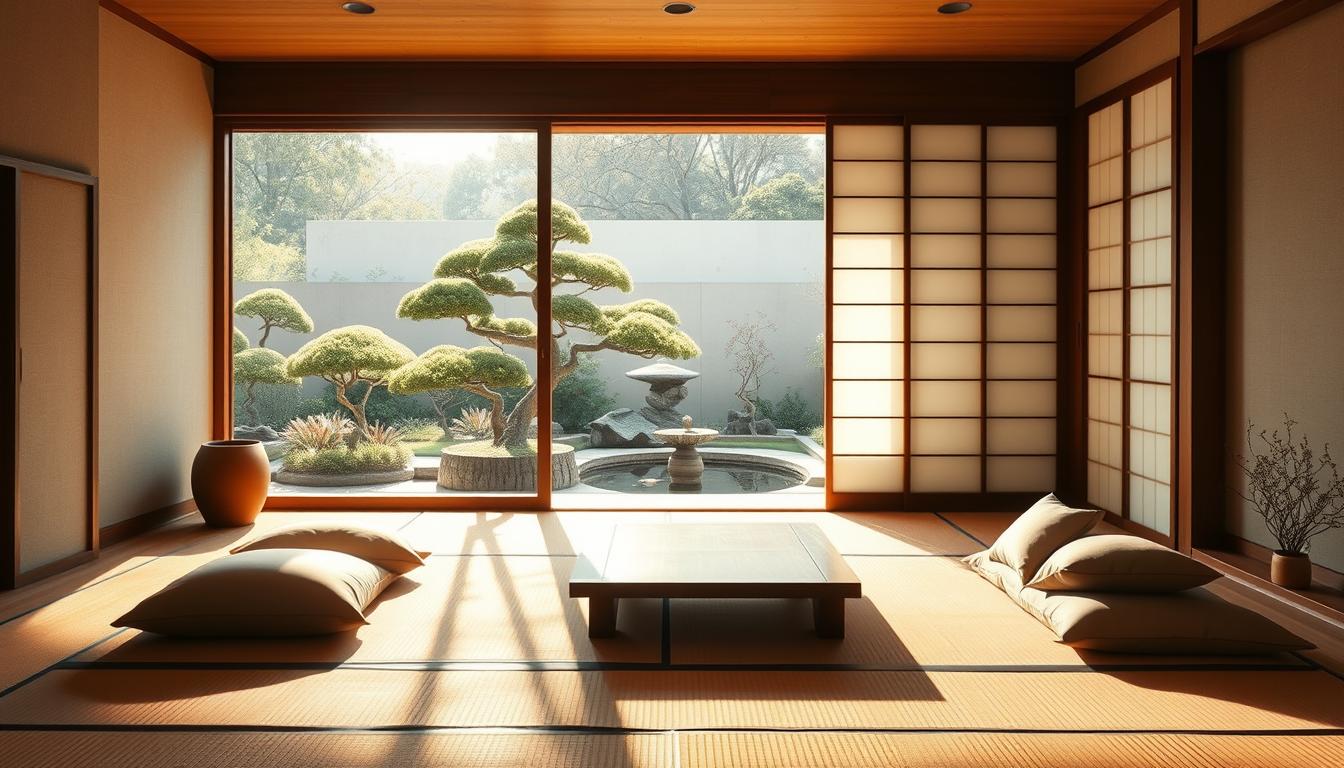Modern living spaces are evolving, blending design with tranquility. More homeowners seek peaceful retreats that balance beauty and simplicity. This trend reflects a growing desire for calm, clutter-free environments.
Natural materials, open layouts, and minimalist decor create harmony in these spaces. Each element serves a purpose while enhancing visual appeal. The result? A soothing atmosphere that promotes relaxation.
We’ve curated 20 exceptional examples showcasing diverse interpretations of this style. From cozy studios to spacious retreats, these homes prove serenity can exist in any setting. Discover how thoughtful details transform ordinary rooms into personal sanctuaries.
Key Takeaways
- Modern interiors increasingly favor calming, minimalist designs
- Natural elements enhance both function and visual appeal
- Open layouts contribute to stress-reducing environments
- Every design choice should serve a practical purpose
- Our curated collection features 20 unique interpretations
Introduction to Zen House Aesthetic Inspiration
Stressful routines have shifted home design toward restorative spaces. People crave environments that counterbalance hectic schedules. This demand has transformed how we think about our living areas.
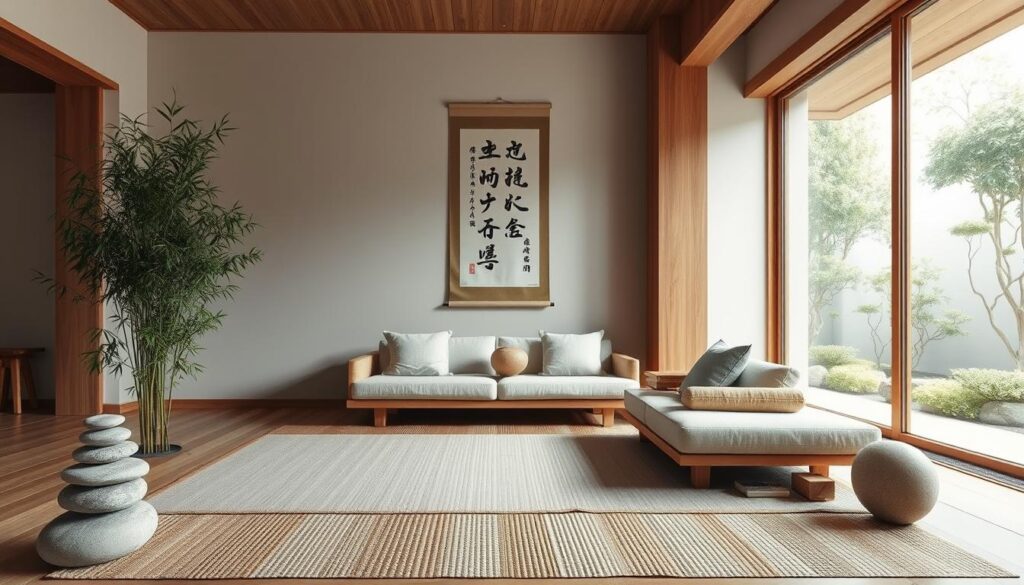
Originally, *zen* concepts were confined to meditation rooms. Now, they influence entire homes. Open layouts and cohesive materials create *bubble environments*—spaces where every element flows seamlessly.
Wondrwood’s research highlights a key benefit: these designs separate work from personal life. Neutral palettes and uncluttered surfaces signal the brain to unwind. The result? A natural shift from productivity to relaxation.
True *zen interiors* engage more than sight. Textured fabrics, soft lighting, and organic scents craft a full sensory experience. It’s not just about looks—it’s about cultivating *peace* in daily life.
The Core Principles of Zen Design
Creating a peaceful home starts with understanding core design principles. These ideas transform spaces into havens of calm. They focus on simplicity, connection to nature, and balanced energy flow.
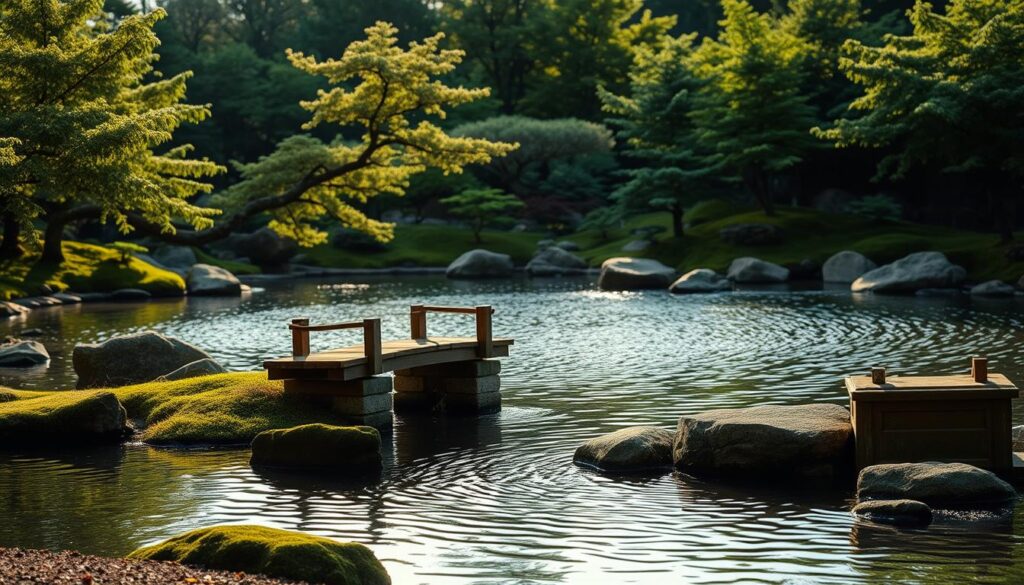
Simplicity and Minimalism
Minimalism isn’t about empty rooms—it’s *intentional curation*. Each item should serve a purpose or spark joy. Wondrwood’s research highlights aligned elements and parallel lines for visual continuity.
Light-toned woods like ash or silver birch add *visual softness*. Avoid overcrowding surfaces. Instead, let key pieces shine.
Harmony with Nature
Biophilic design blends outdoor *elements* indoors. Use raw materials like stone, bamboo, or linen. Organic patterns (e.g., leaf motifs) deepen the connection.
Large windows or indoor plants bridge the gap. They purify air while enhancing *harmony*.
Balance and Flow
Furniture placement guides energy. Try Wondrwood’s perpendicular division technique: arrange seating at right angles for natural movement.
Balance decor proportionally. For example, pair a large sofa with two slim side tables.
| Principle | Key Strategy | Example |
|---|---|---|
| Simplicity | Intentional item selection | Floating shelves with 3–5 objects |
| Harmony | Natural materials | Jute rug + wooden coffee table |
| Balance | Proportional decor | One large art piece flanked by small lamps |
20 Zen Homes That Epitomize Serenity
Transformative living spaces prove serenity isn’t limited by square footage. Each example here balances form and function, creating havens that soothe the senses. Whether sprawling or compact, these designs share one trait: intentional harmony.
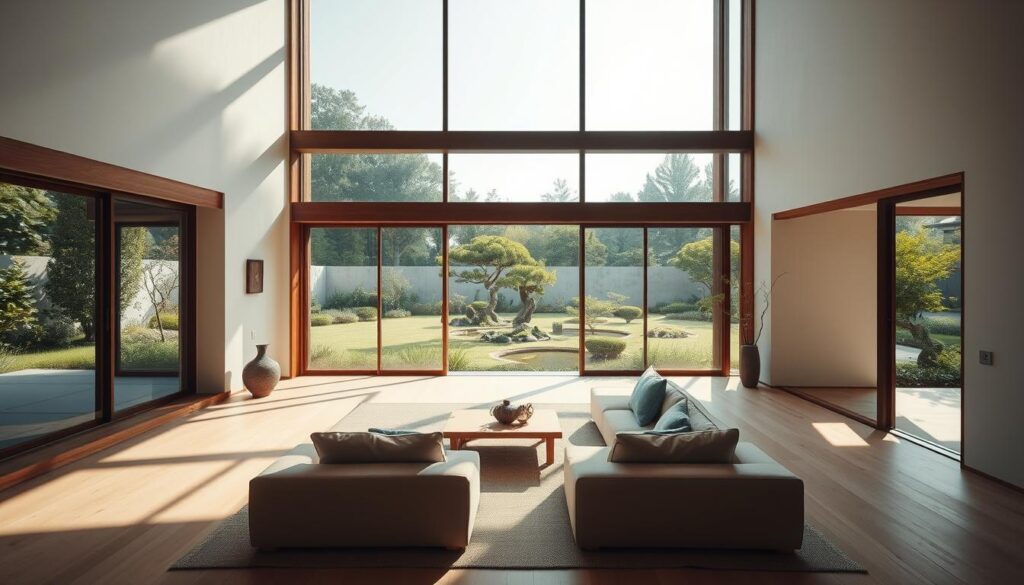
Open-Concept Sanctuaries
Sliding screens replace walls in these airy layouts, adapting to daily needs. One zen home uses Casalgrande’s Petra Bianco tiles to blend kitchen and living areas seamlessly. Light floods through clerestory windows, amplifying the sense of open spaces.
Compact Urban Solutions
Vertical gardens breathe life into tight apartments. A 600 sq. ft. studio demonstrates clutter-free living with built-in storage and foldable furniture.
“Small spaces demand big creativity,”
notes the designer behind thisexample.
Embracing Natural Materials
Reclaimed wood beams and stone accent walls anchor these rooms. Natural elements like hemp rugs and cork flooring add warmth. The textures invite touch, deepening the connection to nature.
Indoor-Outdoor Retreats
Floor-to-ceiling glass doors erase boundaries in these space home designs. A desert retreat pairs terracotta floors with matching patio tiles, creating visual continuity. Evening breezes and birdsong become part of the ambiance.
Each example began with a cluttered or disjointed layout. The transformations highlight how purposeful edits—like swapping heavy drapes for bamboo shades—cultivate calm.
Color Harmony in Zen Spaces
Color choices shape mood more than we realize in calming spaces. Research shows earthy tones like warm beige and soft gray lower cortisol levels by up to 17%. This makes them ideal for creating a serene interior palette.
Choosing Earthy Color Palettes
Wondrwood’s studies highlight chromatic harmony—pairing whites, greys, and beiges for visual flow. Farrow & Ball’s “School House White” or “Elephant’s Breath” offer subtle depth without overwhelming a room.
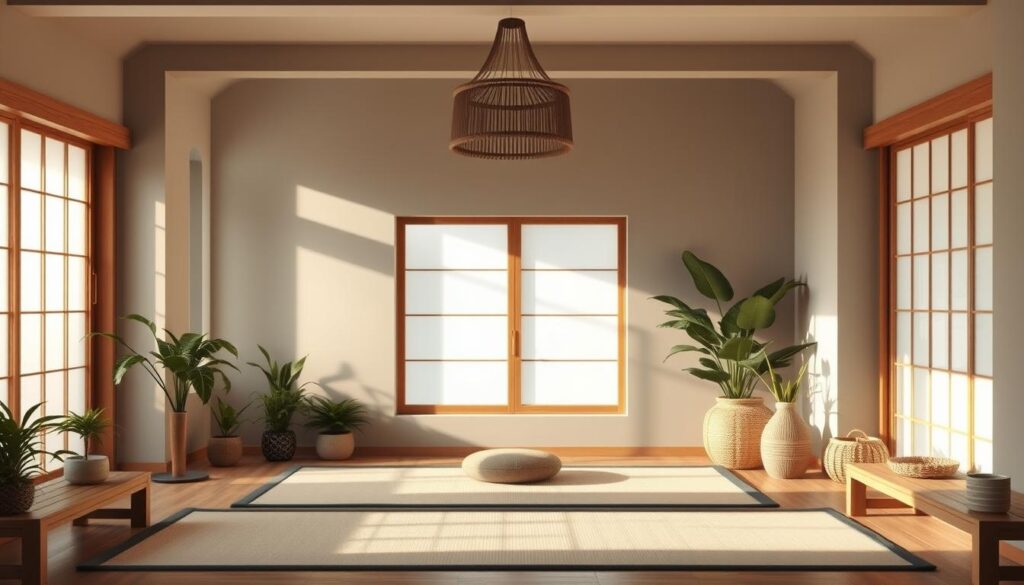
Muted accents can enhance this style. A sage green feature wall or terracotta vase adds warmth while keeping the space grounded. These tones work because they mirror nature’s calming hues.
Soft Neutrals vs. Accent Tones
While Wondrwood favors all-neutral schemes, thoughtful contrasts prevent monotony. Try a matte-finish base (90% of walls) with eggshell-sheen accents for gentle light reflection.
| Strategy | Neutral Approach | Accent Approach |
|---|---|---|
| Wall Color | Warm White (e.g., “Pointing” by F&B) | Muted Terracotta (e.g., “Sulking Room Pink”) |
| Sheen | Matte for uniformity | Eggshell on one wall for depth |
| Decor Pairing | Linen textiles + oak furniture | Handmade pottery in clay hues |
For cohesive harmony, pull inspiration from natural textures like organic rugs that blend seamlessly with neutral backdrops.
Maximizing Natural Light for Zen Interiors
Sunlight transforms rooms into peaceful retreats with just a few design tweaks. Properly managed natural light reduces eye strain while amplifying a sense of openness. These techniques work in any room, from sun-drenched lofts to north-facing spaces.
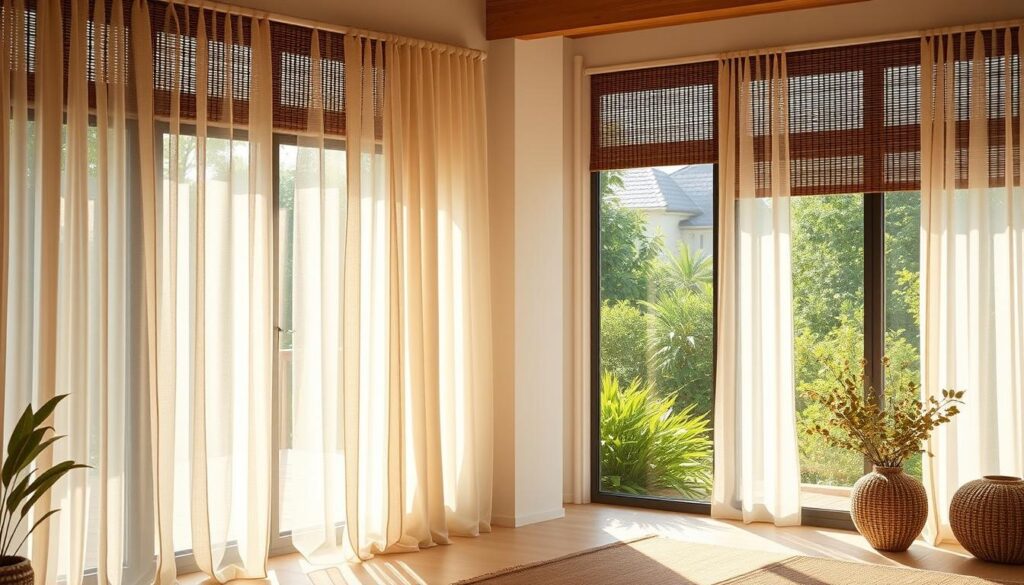
Window Treatments That Enhance Serenity
Wondrwood’s research shows curtains should frame windows while controlling brightness. Extend rods 6-12″ beyond the frame to maximize incoming light when treatments are open.
Compare these popular options:
- Linen: Diffuses harsh rays while maintaining brightness—ideal for reading nooks
- Bamboo: Creates dappled patterns reminiscent of forests; blocks 60% UV rays
For windowless spaces, consider skylights or solar tubes. These open new window possibilities for daylight in bathrooms or hallways.
Strategic Mirror Placement
Position mirrors opposite windows to bounce light into dark corners. A large leaning mirror at 45° angles doubles illumination. Avoid placing reflective surfaces where direct sunlight could damage natural fiber rugs or wood finishes.
Key mirror guidelines:
- Height: Center at 5’7″ for average eye level
- Distance: Place 3-5 feet from light sources
- Shape: Round mirrors soften angular rooms
These adjustments create brighter, more inviting spaces without structural changes. The right balance of natural light and diffusion makes every room feel airier.
Furniture Selection for a Zen Home
Thoughtful furniture choices elevate both form and function in calming spaces. Wondrwood research confirms simple, clean-line pieces promote mental clarity better than ornate alternatives. Every selection should contribute to visual harmony while serving practical needs.
Low-Profile and Multifunctional Pieces
Platform beds from brands like Tatami Room create grounded, spacious feels. Their minimal frames work with any design scheme while supporting proper weight distribution.
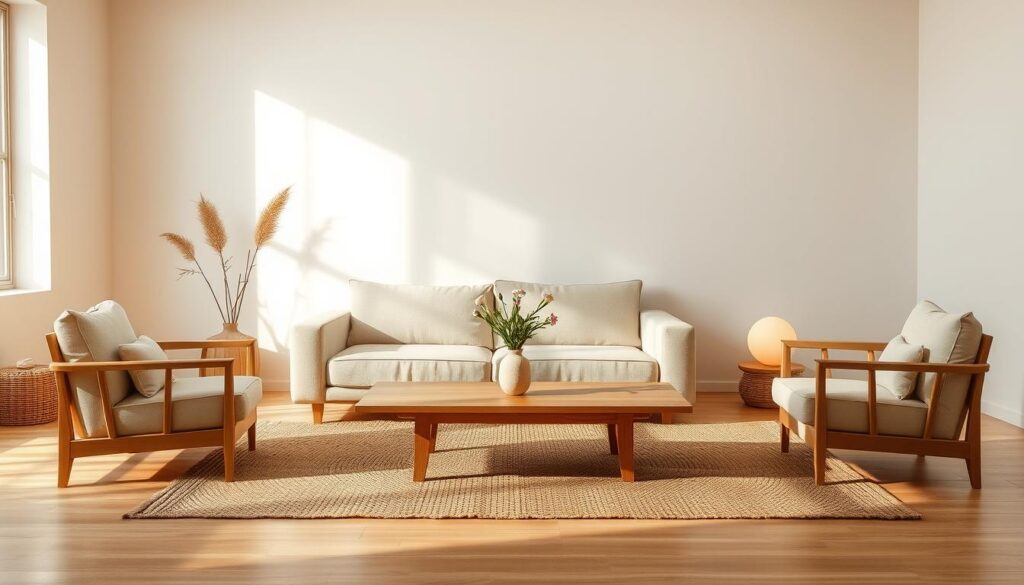
Convertible pieces maximize small areas. Storage ottomans double as seating, and nesting tables adapt to entertaining needs. Look for rounded edges—they soften rooms psychologically.
Natural Materials: Wood, Stone, and Bamboo
Teak withstands heavy use better than bamboo but requires more maintenance. For tabletops, sealed sandstone resists stains while adding organic texture.
- Clean stone surfaces with pH-neutral solutions
- Oil wooden legs quarterly to keep furniture looking fresh
- Choose bamboo for lightweight, eco-friendly options
These natural materials age beautifully, developing character over time. Pair them with neutral textiles for balanced, inviting spaces that stand the test of time.
Decluttering Strategies for Zen Living
Visual calmness thrives when every item has a designated place. Wondrwood’s research confirms concealed storage maintains open spaces by reducing visual noise. These methods blend functionality with minimalist appeal.
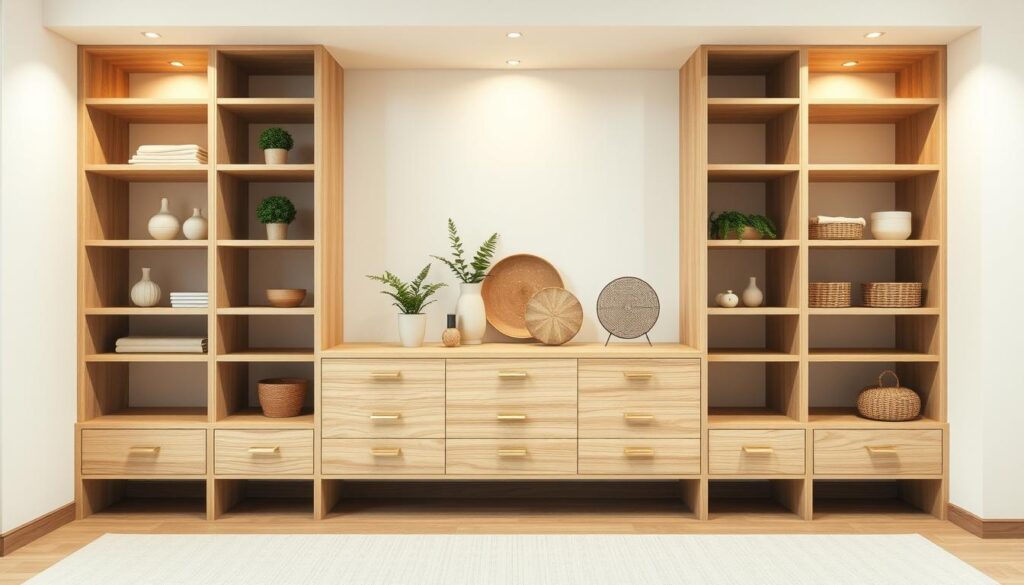
Hidden Storage Solutions
Japanese tokonoma alcoves showcase single art pieces while hiding clutter. These recessed wall niches create focal points without overcrowding.
Under-stair storage maximizes unused space. Custom cabinetry with push-to-open mechanisms keeps daily essentials accessible but invisible. For smaller homes, consider:
- Ottomans with hollow interiors for blankets
- Floating shelves with woven baskets
- Bed frames with built-in drawers
The “One In, One Out” Rule
This principle prevents accumulation by requiring item replacement. Psychology studies show it reduces decision fatigue by 23%—fewer choices mean more peace.
Make sure new purchases serve a clear purpose. Ask:
“Does this add value or just occupy space?”
Digital decluttering matters too. Automate cloud backups and unsubscribe from unused services. A weekly 15-minute tidy-up keeps high-traffic areas like entryways functional.
Incorporating Natural Elements
Bringing the outdoors inside creates an instant sense of calm in any space. These elements do more than beautify—they improve air quality and mental wellbeing. Thoughtful placement turns them into functional art.
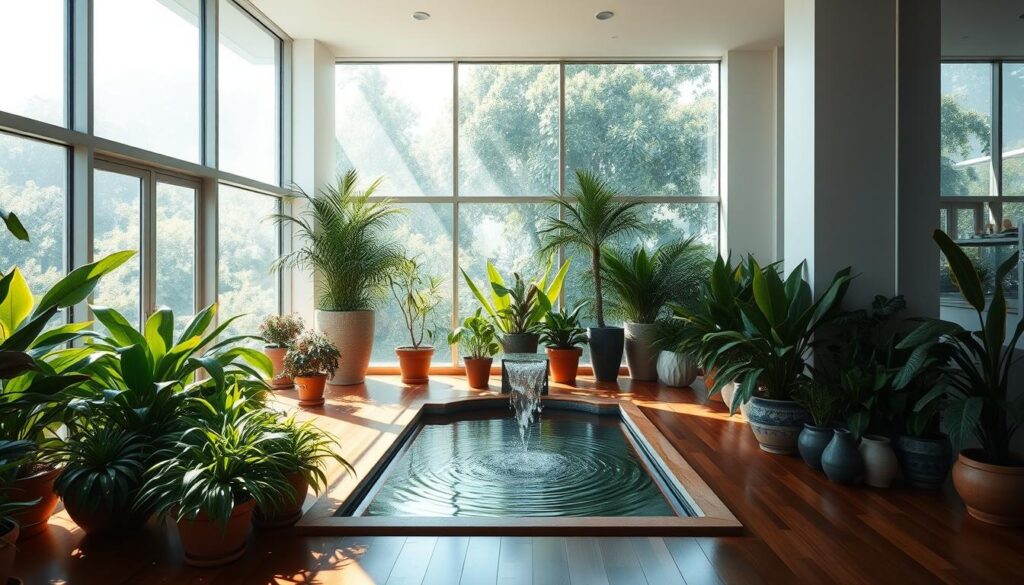
Indoor Plants for Air Purification
NASA studies highlight specific plants that filter toxins while adding life to rooms. Snake plants thrive in low light and remove formaldehyde. Peace lilies and spider plants also make the top list.
For vertical spaces, moss walls offer lush greenery without soil mess. Mist them weekly with distilled water. Rotate potted plants monthly for even growth toward light sources.
Water Features and Their Calming Effects
Wondrwood recommends aquascaped aquariums as dual-purpose elements. The gentle movement of fish pairs with water’s reflective qualities. Tabletop fountains suit small spaces, while wall-mounted designs save floor area.
Keep waterfall sounds between 45-50 decibels—about whisper volume. Use a hygrometer to monitor humidity if adding multiple water pieces. Bamboo water wheels provide visual interest without splash risks.
These natural elements work best when balanced. Pair a tall snake plant with a slender tabletop fountain for harmonious contrast. Let each piece breathe rather than overcrowd surfaces.
Lighting Techniques to Enhance Zen Aesthetics
Lighting transforms spaces more than any other design element. The right balance of brightness and shadow crafts a soothing atmosphere. Wondrwood studies show warm-toned bulbs (yellow-orange hues) reduce stress by 12% compared to cool whites.
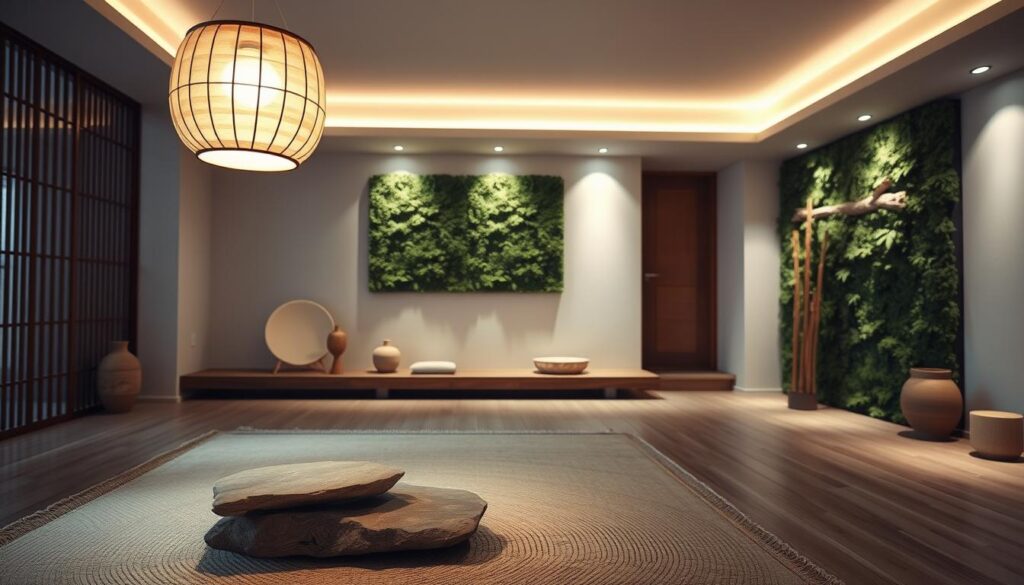
Layered Lighting with Dimmers
Create depth by combining three lighting types:
- Ambient: Overhead fixtures with dimmers (Lutron Caséta recommended)
- Task: Adjustable floor lamps for reading
- Accent: LED strips under shelves
Opt for bulbs between 2700–3000K—this Kelvin range mimics sunset warmth. Smart schedules sync with circadian rhythms, gradually dimming by evening.
Candlelight and Its Role in Ambiance
Flickering flames add unmatched tranquility. For safety:
- Place candles 12+ inches from textiles
- Choose soy wax over paraffin (cleaner burn)
- Use LED alternatives like AmberLit for flameless glow
“Candlelight softens edges and invites relaxation,”
notes a Wondrwood designer. Pair with dimmable fixtures for a layered sense of calm.
These techniques turn any zen interior into a sanctuary. Start with one adjustable fixture, then build your luminous layers.
Textiles and Soft Furnishings for Comfort
Soft furnishings add warmth and texture to minimalist designs. The right textiles transform rigid spaces into inviting retreats. Wondrwood research shows multi-sensory textures at contact points—like armrests or bedding—reduce stress by 14%.
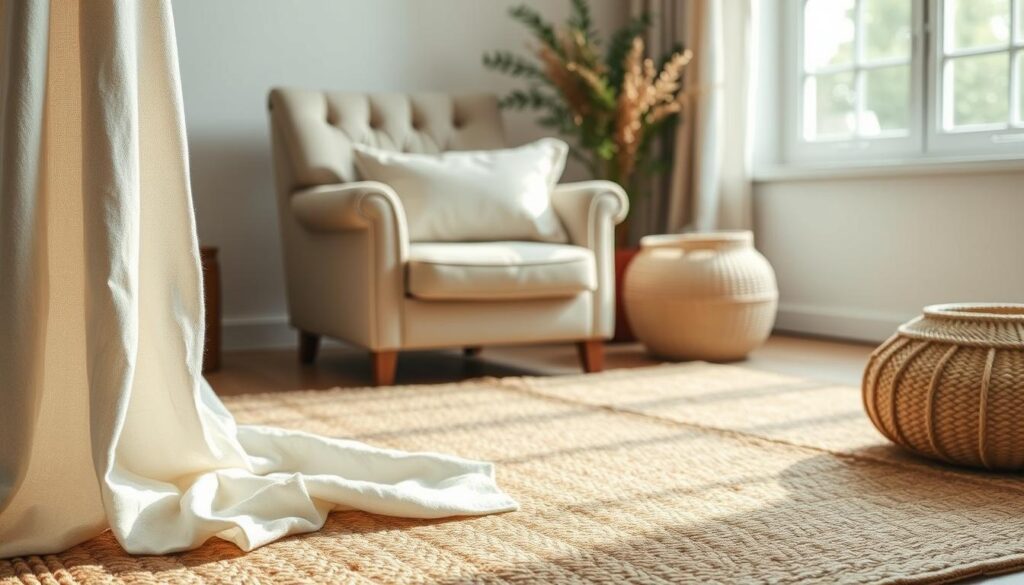
Organic Cotton and Linen Fabrics
Breathability matters more than thread count in hot climates. Egyptian cotton (400 TC) suits cooler areas, while Belgian linen’s loose weave excels in humidity. For custom beauty, try Japanese shibori dye techniques:
- Fold-and-bind fabric before dipping in indigo
- Use wooden blocks for geometric patterns
- Rinse in cold water to preserve vibrancy
The Art of the Perfect Throw Blanket
Weighted blankets (12% body weight) ease anxiety without overheating. Layer them over soft linen sofas for contrast. Key considerations:
- Size: 50″x70″ for couches, 40″x60″ for chairs
- Texture: Chunky knits for visual interest
- Care: Hand-wash with mild detergent to prevent pilling
“A throw should feel like a hug,”
notes a Wondrwood textile designer. Pair with rug pads for non-slip safety under layered rugs.
| Material | Best For | Care Tip |
|---|---|---|
| Organic Cotton | Bedding, curtains | Wash cold, tumble dry low |
| Linen | Upholstery, throws | Steam wrinkles; avoid bleach |
| Bamboo Blend | Towels, rugs | Hang dry to retain absorbency |
These materials blend practicality with quiet beauty. Choose tactile fabrics that invite touch while standing up to daily use.
Conclusion: Crafting Your Personal Zen Sanctuary
Creating a calming space begins with small, intentional changes. Use the 20 examples as inspiration, but adapt them to fit your lifestyle. Start with one room—like a bedroom or living area—and expand gradually.
Track progress with before-and-after photos. Notice how each tweak enhances your sense of peace. Rotate decor seasonally to keep the design fresh yet clutter-free.
Local consultants can help refine your vision. Whether you prefer soft neutrals or natural textures, your home should reflect what soothes you most. The goal? A sanctuary that feels uniquely yours.

